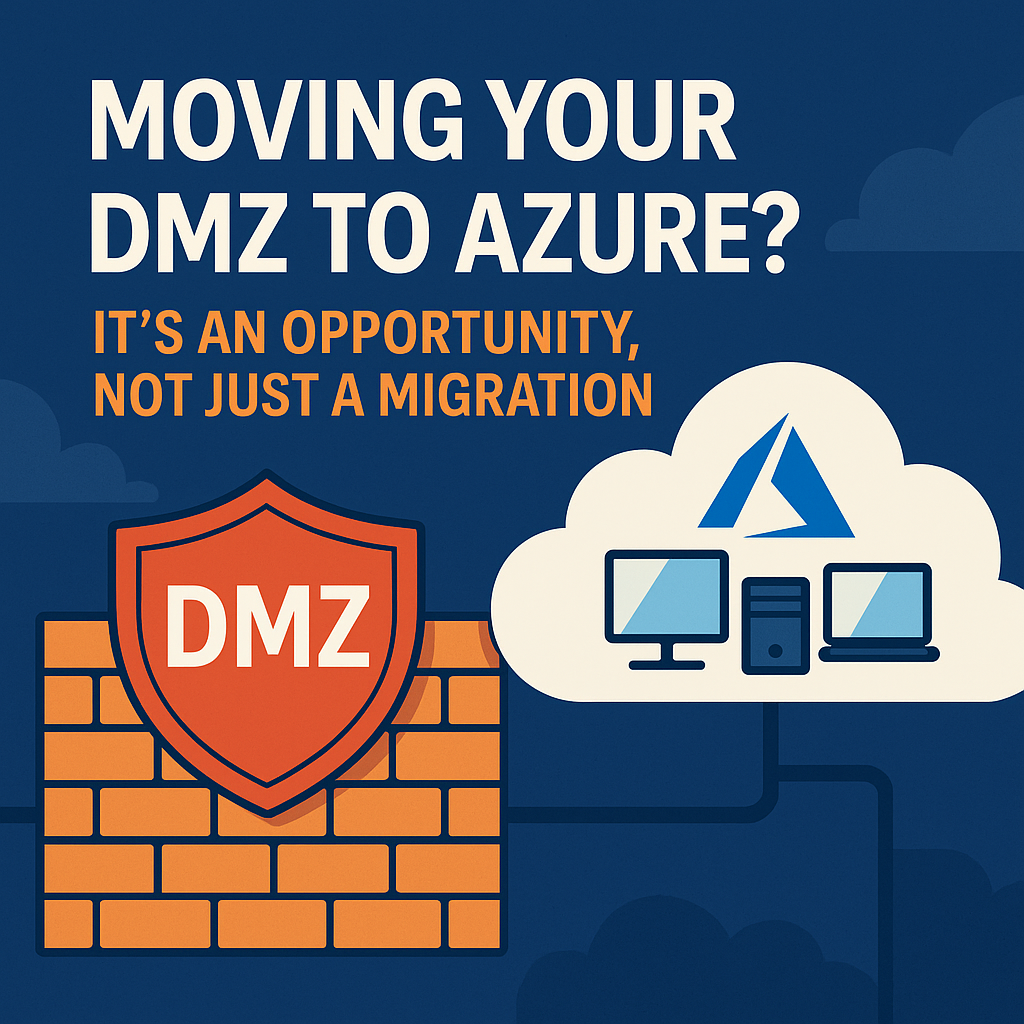Boosting your organisation’s security posture often starts with a simple goal: reducing public endpoints. Many are already on this journey, modernising their environments and shifting applications to SaaS platforms. But there’s often one area left lingering: the DMZ.
Should you dread moving it? Absolutely not. When handled correctly, migrating your DMZ to Azure can seriously strengthen your edge security. We suggest tackling the DMZ relatively early in your cloud journey, rather than leaving it as an afterthought. Why? Because DMZs usually come with existing rigid controls, well-defined firewall rules, and documented dependencies. This foundation often makes the technical side of migration more predictable and less risky compared to other workloads.
Modernise – Don’t Just Lift-and-Shift
Now, while we’re focusing here on improving existing IaaS-based DMZs, it’s crucial to remember: simply ‘lifting and shifting’ your current setup to Azure won’t unlock the full potential of the cloud.
To truly benefit, explore Azure’s modern services that offer enhanced security, scalability, and cost-efficiency. Think about replacing traditional components with cloud-native options, such as:
- App Services with Private Link: A modern way to handle web workloads securely.
- Application Gateway or API Management: Great replacements for reverse proxies or IIS with Application Request Routing (ARR).
- Azure Virtual Desktop (AVD): A secure alternative to RDS Gateways for giving third parties access to legacy applications.
These services align better with cloud-native architecture, improving both how things run day-to-day and your overall cybersecurity.
Tackling Unanswered Challenges in your DMZ with Azure Solutions
1. Simplifying DNS Management
One common headache in traditional DMZs is DNS management. Many rely on local hosts files for name resolution. While this might seem cost-effective and limits discovery, it often creates significant operational complexity and makes management cumbersome.
Azure offers a much cleaner solution: Azure Private DNS Zones.
- Cost-Effective: We’re talking cents per month, typically.
- Centralised Control: Manage DNS easily across multiple VNets and regions.
- No Dedicated Server Needed: Avoids the overhead of managing a separate DNS server VM.
Here’s how to approach it:
- Create a Private DNS Zone containing only the necessary records (like A, CNAME, etc.).
- Link it to your DMZ VNets – using a clear naming convention like <region>-<vnetname> helps keep things organised.
- Decide whether to enable or disable auto-registration based on your specific requirements.
- Configure your VM network interfaces (NICs) to use the Azure DNS IP (168.63.129.16) as their resolver.
- For more complex setups, you might also consider Azure DNS Private Resolvers.
This approach dramatically simplifies administration while keeping your security posture strong.
2. Securely Managing Local Admin Access
Another typical challenge involves managing local administrator access. Often, DMZ servers are workgroup-joined, relying on a shared local admin account. This practice significantly weakens accountability and goes against fundamental security principles like separation of duties.
There’s a much better way in Azure: leveraging Microsoft Entra ID combined with Azure Role-Based Access Control (RBAC).
- Identity-Based Access: Replace shared local accounts with named user accounts.
- Enhanced Security: Enforce Multi-Factor Authentication (MFA) and Conditional Access policies.
- Least Privilege: Assign roles with time limits using Privileged Identity Management (PIM).
- Improved Auditing: Gain better visibility and governance over who accesses what.
Seamless Sign-In with Entra ID (for both Windows and Linux)
A fantastic feature in Azure is the ability for users to sign in to both Windows and Linux virtual machines using their corporate Entra ID credentials. Say goodbye to managing local user accounts or distributing SSH keys!
- For Windows VMs: First, install the Entra ID login extension:
az vm extension set \
–publisher Microsoft.Azure.ActiveDirectory \
–name AADLoginForWindows \
–resource-group <your-resource-group> \
–vm-name <your-vm-name>
Then, assign access using Azure RBAC roles like:
-
- Virtual Machine Administrator Login
- Virtual Machine User Login
Users can then log in via RDP or azure Bastion using their privileged admin account and benefit from Conditional Access to provide MFA.
- For Linux VMs: Similarly, install the Linux extension:
az vm extension set \
–publisher Microsoft.Azure.ActiveDirectory \
–name AADSSHLoginForLinux \
–resource-group <your-resource-group> \
–vm-name <your-vm-name>
Assign one of these RBAC roles:
-
- Virtual Machine Administrator Login (provides sudo access)
- Virtual Machine User Login (standard user access)
Users can then SSH in using their Entra ID username using the Azure CLI or export the configuration to an OpenSSH client:
az ssh vm -n <your-vm-name> -g <your-resource-group>
Users granted the VM Administrator role will be able to run sudo with no other interaction or authentication requirement.
Wrapping Up: Don’t Fear the DMZ Migration – Embrace the Upgrade!
Migrating your DMZ to Azure shouldn’t be seen as a daunting task left for last. Instead, view it as a prime opportunity to significantly enhance your security posture with relatively low friction.
By leveraging Azure-native tools and services like:
- Azure Private DNS Zones for simplified DNS.
- Microsoft Entra ID sign-in for secure, identity-based access.
- Azure RBAC, PIM, and MFA for granular control and strong authentication.
- Modern service alternatives (App Service, App Gateway, AVD) to replace legacy components.
…you can build a secure, manageable, and modern DMZ environment that truly aligns with your overall cloud strategy and security goals.
Ready to modernise your DMZ and strengthen your security posture? Codify’s Azure experts can help you design and implement a future-ready, cloud-native DMZ using Microsoft best practices. Get in touch!

